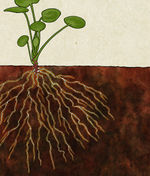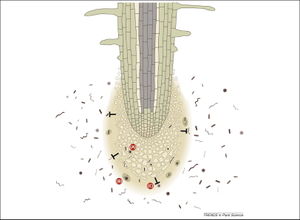Rhizosphere: Difference between revisions
Jump to navigation
Jump to search
No edit summary |
No edit summary |
||
| Line 4: | Line 4: | ||
=Habitat for Critters= | =Habitat for Critters= | ||
=Root Exudation= | =Root Exudation= | ||
Revision as of 15:21, 16 April 2019
Overview

- The rhizosphere is the portion of soil surrounding the roots of plants. It is influenced by chemicals secreted by plants through their roots, called root exudation. Depending on the type of plant, the rhizosphere can extend 2-80 mm away from the roots.
Habitat for Critters
Root Exudation
- Root exudation is the process of chemical excretion from the roots of plants as a means of interaction with the other organisms in soil. In order for a plant to survive and thrive, it must have the ability to detect and perceive changes in the local environment. Root to root and root to microbe commmunication are two types of interactions that occur in the rhizosphere due to root exudation.
- Root to Root interaction includes the growth and development of other plants nearby. The chemical messages sent out in root exudation are signals to prevent invading roots.
- Root to microbe interaction can be used in both positive and negative situations. Positive communication is used in order to attract [mycorrhizal] fungi colonization on the roots, which can aid the plant in getting more nutrients than they are capable of getting alone, as well as nitrogen fixing bacteria. To create nodulation of fungi on their roots, the plants secrete flavonoids that attract the organisms. Negative communication is used when plants need to defend themselves from parasitic [microorganisms] and pathogenic bacteria. In these cases, defense proteins are secreted and continuously attack pathogens.

Root Exudation
References
- [1] Bishnoi, Usha. “Plant Microbe Interactions.” Advances in Botanical Research, 2015, [[1]].
- [2] Cheng, Weixin, and Alexander Gershenson. “Carbon Fluxes in the Rhizosphere.” The Rhizosphere, 2007, [[2]].
- [3] Koo, B-J, and CD Barton. “Root Exudates and Microorganisms.” Encyclopedia of Soils in the Environment, 2005, [[3]].
- [4] Schley, Lacy. “That Word You Heard: Rhizosphere.” Discover, 11 Feb. 2019, [[4]].
- [5] Walker, Travis S., et al. “Root Exudation and Rhizosphere Biology.” Plant Physiology, [[5]].